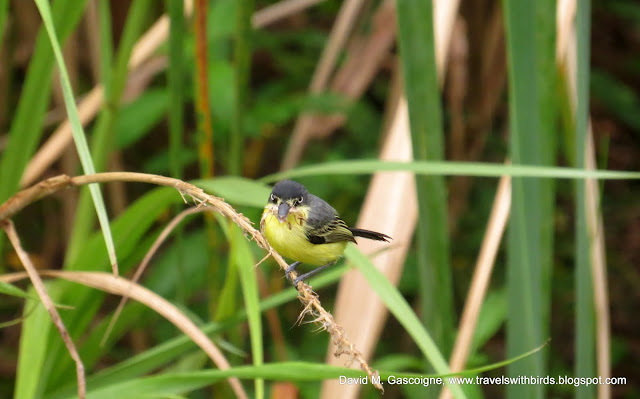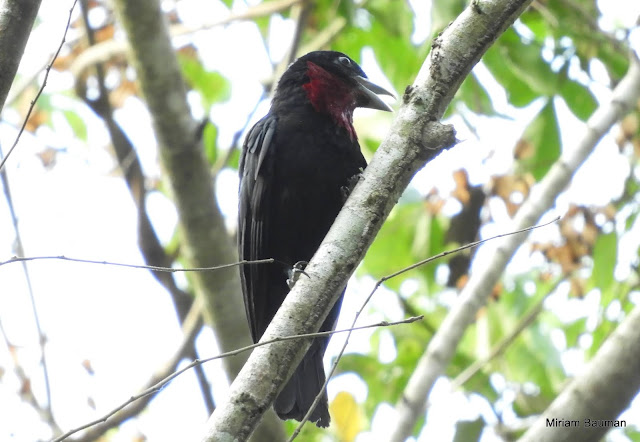Canopy Tower - Parque Natural Metropolitano - Canopy Tower - Pipeline Road - Ammo Ponds - Canopy Tower
The day began with the most incredible news of all. Our young friends Josh and Jill Shea welcomed into the world their first child, a son, Mason Daniel Shea, and Josh sent us a picture. We could not have been happier for Josh and Jill. This news overshadowed anything else that day.
What a handsome little fellow. He has no doubt inherited Jill's good looks!
Obviously they need to rush out right away and get him his first field guide!
Buoyed by this great news we went up onto the observation deck where, as always, a Palm Tanager (Thraupis palmarum) was one of the first birds to greet us.
This species is never reluctant to breed around humans, and given the frequency with which birds flew in and out below the deck, probably had a nest (or nests) there. As tanagers go it is one of the drabber species but possessed of great appeal nonetheless.
Every morning Red-lored Amazons (Amazona autumnalis) could be counted on to take up their position atop the foliage, thrilling everyone who saw them.
A male Blue Dacnis (Dacnis cayana) perched in the open long enough for everyone to get a good look and take pictures. I am sure you will all agree that it is a stunning bird.
This juvenile male Green Honeycreeper (Chlorophanes spiza) is just beginning to transition to adult plumage; yet looks very dapper still.
Soon this is what he will look like as an adult male.
After a substantial breakfast we went downstairs to join Jorge and Beto for a trip to Parque Natural Metropolitano, a large park in the heart of Panama City, a migrant trap much in the manner of Central Park in New York.
We found it to be a fabulous spot and were encouraged to see many people out enjoying nature. Two young fellows doing some preliminary scouting for an upcoming 24 hour bird survey pointed us in the direction of a Northern Parula (Setophaga americana), a decidedly rare migrant at this location.
One may see sloths often (in fact one hopes to see sloths often) but they always merit a good deal of attention. I know that Miriam and I never tire of seeing these fascinating, slow-moving creatures. Thus, this Brown-throated Three-toed Sloth (Bradypus variegatus) added a good deal of pleasure to our morning in the park.
The trails were many and varied.
And it is always worthwhile to glance off to the side.
Bay-breasted Warbler (Setophaga castanea) was probably the single most common migrant warbler we saw, in every plumage phase imaginable.
A White-shouldered Tanager (Tachyphonus luctuosus) is not the most colourful of thraupids but is dramatic and handsome nevertheless, as this male clearly shows.
Several trees were festooned with mangoes, leaving us to wonder whether people harvested them when ripe or whether they were left for the animals.
Given my preference for mango above almost all other fruit I would be happy to make a return visit when the fruit is ripe!
The park contained many different species of trees and much other interesting vegetation.
Miriam got a nice closeup of a male Slaty-tailed Trogon (Trogon massena).....
..... and this shot shows the kind of habitat it favours.
I am not sure who located a White-necked Puffbird ( Notharchus hyperrhynchus) but it may well have been Larry who seemed to find this species more often than any of us.
This lizard was very attractive and I believe that it is a type of Whiptail.
It was time to return to the Canopy Tower for lunch; it had been a very enjoyable visit indeed. Jorge took us back alongside the Panama Canal where we saw many Magnificent Frigatebirds (Fregata magnificens) and Brown Pelicans (Pelecanus occidentalis).
As usual it was siesta time until 15h:00 when we left on a birdmobile to visit a section of Pipeline Road we had not previously visited and a repeat visit to the Ammo Ponds to try again for White-throated Crake (Laterallus albigularis). Miriam decided to stay back at the tower so we have very few pictures for the afternoon's efforts.
During our time at Pipeline Road Black-chested Jays (Cyanocorax affinis) were moving through the treetops often detected initially by their calls, and equally often concealed behind foliage. I did manage this shot of a couple in the open, however.
It was very interesting to watch a Common Tody-Flycatcher (Todirostrum cinereum) gathering nesting material at close range.
At the Ammo Ponds we had barely gotten down from the birdmobile when a White-throated Crake, and then two of them, popped into view. Sometimes you get lucky. We had terrific looks at the bird through the scope, but given its small size (14 cm), the distance, and the fact that it was in and out of dense reeds, it was impossible to get a picture.
I do not recall what we had for dinner but my notes say it was terrific and we were joined at the table by interesting new visitors and a pleasant evening ensued.
All species 06 April: Great Tinamou (heard), Little Tinamou, Grey-headed Chachalaca, Rock Pigeon, Pale-vented Pigeon, Scaled Pigeon, White-tipped Dove, Squirrel Cuckoo, Greater Ani, Short-tailed Swift, White-necked Jacobin, Long-billed Hermit, Snowy-bellied Hummingbird, Rufous-tailed Hummingbird, Violet-bellied Hummingbird, White-throated Crake, Purple Gallinule, Wattled Jacana, Magnificent Frigatebird, Brown Pelican, Rufescent Tiger Heron, Green Heron, Black Vulture, Turkey Vulture, Mississippi Kite, Short-tailed Hawk, Slaty-tailed Trogon, Black-tailed Trogon, Gartered Trogon, Whooping Motmot, White-necked Puffbird, Pied Puffbird (heard), Collared Araçari, Keel-billed Toucan, Red-crowned Woodpecker, Crimson-crested Woodpecker (heard), Yellow-headed Caracara, Orange-chinned Parakeet, Red-lored Amazon, Mealy Amazon, Fasciated Antshrike, Black-crowned Antshrike, Dot-winged Antwren, Olivaceous
Woodcreeper (heard), Cocoa Woodcreeper, Brown-capped Tyrannulet, Yellow-crowned Tyrannulet (heard), Forest Elaenia, Greenish Elaenia, Southern Bentbill, Common Tody-flycatcher, Yellow-olive Flycatcher, Ruddy-tailed Flycatcher, Eastern Wood Pewee, Bright-rumped Attila (heard), Dusky-capped Flycatcher, Great Kiskadee (heard), Social Flycatcher, Streaked Flycatcher, Piratic Flycatcher, Tropical Kingbird, Eastern Kingbird, Cinnamon Becard, Lance-tailed Manakin, Golden-collared manakin, Green Shrike-Vireo, Lesser Greenlet, Golden-fronted Greenlet, Red-eyed Vireo, Black-chested Jay, Mangrove Swallow, Barn Swallow, Black-bellied Wren, Long-billed Gnatwren, Clay-coloured Thrush, Orange-billed Sparrow, Chestnut-headed Oropendola, Yellow-backed Oriole (heard), Yellow-tailed Oriole (heard), Baltimore Oriole, Great-tailed Grackle, Northern Parula, Bay-breasted Warbler, Blackburnian Warbler, Yellow Warbler, Chestnut-sided Warbler, Summer Tanager, Scarlet Tanager, Red-throated Ant Tanager, Palm Tanager, Golden-hooded Tanager, Plain-coloured Tanager, Green Honeycreeper, White-shouldered Tanager, Crimson-backed Tanager, Blue Dacnis, Buff-throated Saltator.
07 April 20198
Rainforest Discovery Centre - Canopy B&B - Chagres River Area - Gamboa Rainforest Resort
We had breakfast at 05h:30 so that we could get an early start for the Rainforest Discovery Centre to try to catch the cool of the day. Jorge and Beto were our trusty guides for the morning.
Before starting to climb up the tower, we located a male Spotted Antbird (Hylophylax naevioides) in the gloom of the undergrowth.
Depending on who you listened to the ascent to the to the observation deck at the top was either 175 steps or 177. Miriam says she counted 175 and that's good enough for me.
The view was quite magnificent.
It was early morning and already it was very hot; before going back down it was sweltering. And the humidity would have made a steam bath seem dry.
As may be seen the top of the tower rises above the canopy affording a view not seen from the ground.
One of the first birds we saw, up close in good light, was a female Blue Dacnis. I don't recall ever having such a splendid view of this bird.
For my money, the female is every bit as appealing as the male.
This was followed in short order by a couple of Red-legged Honeycreepers (Cyanerpes cyaneus) similarly perched atop a tree with no intervening branches or other distractions - a unique perspective indeed.
When I saw the following bird at the time, I thought it was a female Blue Cotinga (Cotinga nattererii), the first I had ever seen, but in looking at the picture now I think it is a young male just starting to acquire adult plumage.
Birds were not flying around in large numbers and it required vigilance and persistence to find them, but when you did the views were superb.
Mississippi Kites (Ictinia mississippiensis) were migrating in substantial numbers and, although distant, were at eye level or slightly higher, quite different from the neck-craning experience so familiar to hawk watchers. I suspect there are those with permanent neck kinks and nagging aches from years of such habits.
Yellow-throated Toucans (Ramphatos ambiguus) were seen quite frequently flying across the top of the canopy and every so often one would perch for a while, not too far distant.
A Snail Kite (Rostrhamus sociabilis), our only one of the trip, kept on going, but this Grey-headed Kite (Leptodon cayanensis) was a little more obliging. It too proved to be the only one of its kind we would see.
After a couple of hours in the heat we descended and returned to the somewhat cooler forest below (everything is relative!).
Butterflies were always numerous, and colourful too.
We were fortunate in seeing at least three or four Long-billed Hermits (Phaethornis longirostris) and were able to take several pictures.
Leaf Cutter Ants (genera Atta or Acromyrmex) were active on the forest floor, industrious as always, tarnsporting loads that seem to defy belief.
This lizard was very attractive but I have been unable to come up with a name for it.
A Brown Vine Snake (Oxybelis aeneus) presented no such problem.
At a visitor centre there were several hummingbird feeders with staff there to interpret for the general public. The following species were seen.
 |
| White-necked Jacobin ♀ |
 |
| Crowned Woodnymph |
 |
| White-necked Jacobin ♂ |
 |
| Bronze-tailed Plumleteer |
Other than for Larry, our entire group was Canadian, and it was ironic that we chatted with a fellow who was walking around and he was from Parry Sound, ON.
One of the great finds of the day was a Purple-throated Fruit Crow (Querula purpurata), a very enigmatic member of the Cotingidae.
Just before leaving we also got pretty decent looks at a Red-throated Ant Tanager (Habia fuscicauda).
We returned to the Canopy Tower, well satisfied with another great day immersed in nature. We had a glass of wine, enjoyed the snacks, completed the checklist and had dinner. Most of us chatted until quite late, following which we retired to dream of new thrills in store for the morrow.
All species 07 April: Great Tinamou (heard), Black-bellied Whistling Duck, Muscovy Duck, Grey-headed Chachalaca, Pale-vented Pigeon, Scald Pigeon, Short-billed Pigeon, Ruddy Ground Dove, White-tipped Dove, Short-tailed Swift, White-necked Jacobin, Long-billed Hermit, Purple-crowned Fairy Crowned Woodnymph, Blue-chested Hummingbird, Snowy-bellied Hummingbird, Sapphire-throated Hummingbird, Violet-bellied Hummingbird, Purple Gallinule, Common Gallinule, Southern Lapwing, Wattled Jacana, Anhinga, Brown Pelican, Little Blue Heron, Tricoloured Heron, Cattle Egret, Green Heron, Striated Heron, Glossy Ibis, Black Vulture, Turkey Vulture, King Vulture, Western Osprey, Grey-headed Kite, Snail Kite, Mississippi Kite, Broad-winged Hawk, Swainson's Hawk, Slaty-tailed Trogon, Black-tailed Trogon (heard), White-necked Puffbird, Black-breasted Puffbird, Collared Aracari, Keel-billed Toucan, Yellow-throated Toucan, Red-crowned Woodpecker, Cinnamon Woodpecker, Crimson-crested Woodpecker, Yellow-headed Caracara, Orange-chinned Parakeet, Brown-hooded Parrot, Blue-headed Parrot, Red-lored Amazon, Mealy Amazon, Black-crowned Antshrike, Moustached Antwren, Dot-winged Antwren, Spotted Antbird, Cocoa Woodcreeper, Streak-headed Woodcreeper, Forest Elaenia, Mistletoe Tyrannulet, Common Tody-Flycatcher, Yellow-margined Flycatcher, Ruddy-tailed Flycatcher, Bright-rumped Attila (heard), Dusky-capped Flycatcher, Rusty-margined Flycatcher, Piratic Flycatcher, Tropical Kingbird, Eastern Kingbird, Fork-tailed Flycatcher, Purple-throated Fruitcrow, Blue Cotinga, Blue-crowned Manakin, Golden-collared Manakin (heard), Green Shrike-Vireo, Lesser Greenlet, Grey-breasted Martin, Southern Rough-winged Swallow, Barn Swallow, Black-bellied Wren, Song Wren (heard), Tropical Gnatcatcher, Clay-coloured Thrush, Fulvous-vented Euphonia, Chestnut-headed Oropendola, Scarlet-rumped cacique, Yellow-rumped Cacique, Yellow-backed Oriole, Great-tailed Grackle, Chestnut-sided Warbler, Canada Warbler, Summer Tanager, Red-throated Ant Tanager, Palm Tanager, Golden-hooded Tanager, Grey-headed Tanager, White-shouldered Tanager, Flame-rumped Tanager, Crimson-backed Tanager, Red-legged Honeycreeper, Blue Dacnis, Variable Seedeater, Streaked Saltator.

































































.svg.webp)













